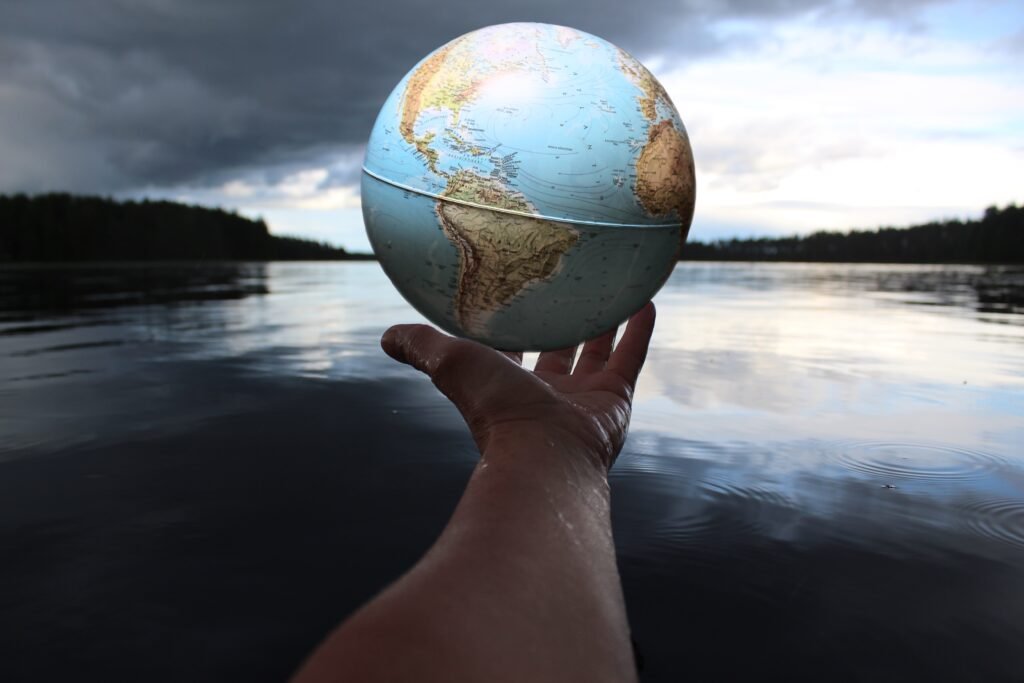CLIMATE ZONE IN USA

CLIMATE ZONE IN USA: In the 20th century, I have witnessed profound changes in global climate, marked by rising temperatures, increasing sea levels, altered snow and ice cover, and shifts in weather patterns. These changes, consistent with the greenhouse effect, are attributed to escalating greenhouse gas emissions from human activities such as fossil fuel combustion, deforestation, and land use changes.
Climate, the long-term average of regional or global temperature, humidity, and precipitation patterns, distinguishes itself from short-term weather fluctuations. Human-induced alterations in the atmosphere, direct (gas or particle emissions) and indirect (atmospheric chemistry changes), have significantly contributed to climate change. Anthropogenic emissions during industrialization fall within the range of well-mixed greenhouse gases (WMGHGs).
Radioactive forcing (RF), a measure of Earth’s energy balance response to external factors, is crucial for understanding temperature consequences. Climate monitoring involves physical measurements, remote sensing, and paleoclimate reconstructions, offering insights into Earth’s past climates.
The United States, a geographically diverse nation, exhibits various climate zones influenced by its size, topography, and proximity to oceans. The Eastern U.S. experiences a temperate climate, while the Subtropical South sees hot, rainy summers. Central to the U.S., the Continental climate zone witnesses significant temperature variations. The climate classification system, based on the Köppen-Geiger method, categorizes climates into tropical (A), arid (B), temperate (C), continental (D), and polar (E) groups.
Research collaboration between the U.S., Canada, and Mexico enhances the tracking and monitoring of North American climate zones, aiding local decision-makers. The diverse U.S. climate impacts vegetation and ecosystems, from broadleaf evergreen forests in the southeast to arid deserts in the southwest—the continental climate zone, with substantial temperature variations, influences plant and animal life. In conclusion, the discussion underscores the intricate link between U.S. climate zones and observed environmental changes.
The impact of climate change, driven by heightened greenhouse gas concentrations from human activities, manifests differently across regions, shaping distinct vegetation and ecosystem patterns. Recognizing these variations is pivotal for informed decision-making amid ongoing climate challenges. Climate change
Visible changes in the 20th century:
Include increases in global climate and ocean temperatures, rise in international sea level, extended periods and expansions in snow and ice cover, changes in weather and seawater exchange, and regional weather patterns affecting seasonal precipitation.
These changes are due to adding greenhouse gases to the atmosphere, which creates more heat in the atmosphere. These additional greenhouse gases are consumed mainly by human activities such as burning fossil fuels (coal, oil, and natural gas), deforestation, agriculture, and land use.
The atmosphere contains more “heat-trapping” greenhouse gases due to these activities. The observed pattern of climate change is consistent with the greenhouse effect. Other climatic factors, such as volcanoes, solar radiation, and natural variations, cannot explain the timing and extent of these changes.
Climate refers to the long-term regional or global average:
patterns of temperature, humidity, and precipitation over a season, year, or multi-year period.
Although the weather can change in just a few hours, the weather can change for much longer. Climate change is a significant change in the average climate that becomes warmer, wetter, or drier over decades. This is a long term that distinguishes climate change from natural climate change.
Human activities cause changes:
In the atmosphere directly (through gas or particle emissions) or indirectly (through atmospheric chemistry). During industrialization, anthropogenic emissions varied within the WMGHG range. Radioactive forcing (RF) measures the change in the Earth’s energy balance in response to some external factor; Positive RF causes heat, and negative RF causes cold.
RF is essential to compare the consequences of the Earth’s average temperature for most people, affecting the Earth’s electrical balance. Figure 4 shows the radioactive forcing and effective radioactive forcing (ERF) in the changes from 1750 to 2011, along with the associated uncertainty.
BACKGROUND:
The Earth’s climate is changing and is expected to continue changing this century and beyond. The severity of climate change over the next decade will depend on the uncertainty of greenhouse gas (heat tapping) emissions worldwide and the world’s sensitivity to responding safely to emissions.
As greenhouse gas (GHG) emissions decrease, the global average annual temperature increase may be limited to 2°C or less. But without reducing these emissions, the global average yearly temperature increase compared to the pre-industrial period could reach five °C or more by the end of this century. In contrast, the global climate continues to change rapidly.
The amount of climate change that has occurred throughout Earth’s history. Global mean temperature trends, sea level rise, sea level tops, ground ice melt, Arctic ice, summer permafrost thaw depth, and other climate variables provide consistent evidence of global warming.
This graph shows how hot or cold the global annual temperature was during 1880-2022 compared to the 1881–1910 average. Years in which temperatures were higher than in the early economic period are shown in red. It is found in the blood yearly when the temperature is below alkaline.
Climate monitoring relies on direct physical and biogeochemical measurements and remote sensing from ground stations and satellites. Data from pale climate archives provide long-term context for past climates. Various environmental evidence is used to understand Earth’s past climate and why.
Security records are stored in tree rings, sealed in the bones of skeletons, packed in ice and sheets of ice, and buried in layers in lakes and oceans. Scientists can use this environmental information to predict past events, extending our understanding of climate back hundreds or even millions of years.
The main period of global observations began in the mid-19th century, and paleoclimate reconstructions extend some records back hundreds or even millions of years. Together, this provides a comprehensive view of changes and long-term changes in the atmosphere, oceans, cry sphere, and land.
LITERATURE REVIEW:
Differences between climate zones in the United States
The United States is the fourth largest country in the world regarding area. The United States is a large country spanning the North American continent and surrounded by two oceans, the Atlantic Ocean to the east and the Pacific Ocean to the west. Some of the United States’ highest peaks rise skyward in the Rocky Mountains.
Primary and foreign countries in the United States:
Create various climate zones and extreme temperature fluctuations in some regions. The United States has a climate zone for every climate type: climate zones with different seasons, continental zones with varying temperatures between winter and summer, and tropical zones with year-round sunshine.
The tides affect the coast:
There is little change each year. The further away you are in the region, the more significant the seasonal difference. The Midwest and Midwestern United States experienced the worst weather due to the Rocky Mountains blocking wind and rain from the Pacific Ocean. But some places, such as Northern Alaska or the Hawaiian Islands, are cold or hot all year round. But let’s learn more about the different climate zones in the United States:
Climate of the Eastern United States The eastern half of the United States is influenced by the Atlantic Ocean and the Gulf of Mexico. It is divided into two main climate zones: the temperate climate of the Northeast and the tropical climate of Southeast Asia.
Temperate Regions of New England:
Many New England states have a temperate climate with cold winters and hot summers. However, temperatures of -0°C and heavy snowfall in winter are rare, especially in northern states such as Maine or Vermont. Precipitation is fairly even throughout the year due to the influence of the Atlantic Ocean.
Continental climate in the north:
The further west you go, the more continental climate is observed. In some inland regions, annual temperature changes exceed 30°C. In cities like Chicago or Des Moines, winters are frigid, and summers are hot. Precipitation gradually decreases towards the west. In addition, in the middle of the continent, the weather is very different in winter and summer, with strong winds and strong winds.
Eastern United States Climate
Subtropical South: Much of the southern United States has a subtropical climate. The northern boundary of the temperate zone begins at the height of the Chesapeake Bay in Virginia and extends into Tennessee, North Carolina, Georgia, Texas, and Florida. Only the southern part of the “Sunshine State,” along with the Everglades and Florida Keys, is classified as part of the tropical climate zone.
In the southeastern United States: summers are hot and rainy, and winters are hot and rainy. It is light. However, there are many differences in terms of climate on this continent. The further north a state is the colder the winters.
Northern parts of the United States can experience a lot of snow during the winter months. In contrast, thermometers in the Gulf of Mexico region read + degrees every year. Annual precipitation is approximately 1,000 mm and is distributed evenly throughout the year.
FRAM WORK:
A combination of letters represents each category and region. Tropical (A), dry (B), temperate (C), continental (D), and polar (E) are the primary climatic groupings. Subspecies are identified using additional labels that describe seasons and weather characteristics such as temperature and precipitation.
The Commission conducted research with our partners in Canada, Mexico, and the United States to improve tracking and monitoring for local and
Regional decision-makers and communities: By improving the orientation of regional indicators for North American climate zones. It can prepare for drought conditions. Soil moisture stands out as the only indicator considered as drought. Applicable to all climates in North America.
Two additional hands (products and storage) were practical in most environments. The results of this study are summarized in the Handbook of Drought Indices and Indicators Used in North America, available online. Get CEC’s virtual library. The climate classification is derived from the Köppen-Geiger climate classification, which divides the climate into five main groups based on precipitation and temperature patterns. A stands for tropical, B for desert, C for temperate, D for continental, and E for polar.
The climate of the United States is very diverse: From tropical climates in southern Florida and Hawaii to arctic and alpine environments in Alaska and the Rocky Mountains. Temperatures in the continental United States show strong gradients between regions and seasons, from extreme temperatures in the southern coastal states, where the average annual temperature is above 21°C, to cold weather in the northern part of the country along the Canadian border.
The plain’s summer and winter temperature difference reaches 50 °C and ten °C, respectively.
Similarly, rainfall varies across the country and seasonally: Annual precipitation on the Gulf Coast is more than 127 centimeters, while the Western Mountains and Southeast may experience less than 30 centimeters of precipitation annually. Seasons with heavy rainfall also vary from region to region.
Many areas of the Great Plains and the Midwest experience late spring, the West Coast states experience significant winter over season, the western desert is affected by the North American monsoon during the summer and many Gulf and Atlantic coast regions experience summer peaks.
The United States experiences nearly every type of extreme weather: Including severe hurricanes, about 1,500 tornadoes per year, and an average of 17 hurricanes per decade reaching the Gulf of Mexico and Atlantic coasts. Approximately 20% of the country is in crisis at any given time.
FAQS of CLIMATE ZONE IN USA:
How many climate zones are there in the United States?
The oldest and most widely used system, developed by the United States Department of Agriculture (USDA) as rough guides for landscaping and landscaping, identifies 13 areas based on average annual temperature.
What kind of climate is California?
California is one of the few places where five essential climate sorts occur nearby. Here, the desert, Cool interior, Highland, and Steppe climates border a smaller location of Mediterranean weather.
How do the climate zones in the U.S. impact the types of vegetation and ecosystems present in different regions?
The diverse climate zones in the United States significantly influence the types of vegetation and ecosystems present in different regions. For example, In the humid subtropical climate zones in the southeastern U.S., broadleaf evergreen forests and swamps are prevalent.
Arid and semiarid areas of the southwest are characterized by deserts and grasslands adapted to low water availability. The temperate climates in the Midwest and Northeast support deciduous forests, while alpine vegetation is found in high-altitude mountainous areas.
In which climate zone would you expect to find the most significant temperature variations?
The climate zone with the most significant temperature variations throughout the year is likely the continental climate zone. This zone in the central U.S. experiences hot summers and cold winters. The temperature range between summer and winter can be substantial, impacting both plant and animal life.
CONCLUSIONS:
In conclusion, the discussion highlights the intricate relationship between climate zones in the United States and the observable changes in temperature, precipitation, and ecosystems. The 20th-century trends of increasing global climate and ocean temperatures, rising sea levels, altered snow and ice cover, and shifts in weather patterns are unequivocally linked to the heightened concentration of greenhouse gases in the atmosphere.
Human activities, notably the burning of fossil fuels, deforestation, and changes in land use, contribute significantly to this phenomenon. The impact of climate change is not uniform across the diverse climate zones of the United States. Each region experiences distinct vegetation and ecosystem patterns shaped by its specific climate characteristics.
The interplay of climate and ecology is evident from the humid subtropical zones in the southeast, fostering evergreen forests to the arid southwest supporting desert landscapes. Furthermore, the continental climate zone stands out for its notable temperature variations, experiencing hot summers and cold winters that influence flora and fauna.
REFERENCES:
- https://climateknowledgeportal.worldbank.org/overview
- https://www.google.com/search?q=u.s.+climate+zones+by+state⦁ &⦁ sca_esv=587464862⦁
&⦁ rlz=1C1ONGR_enPK1041PK1041⦁ &⦁ sxsrf=AM9HkKkyKardsMBzycKt6kIr-UnDaMwffQ%3A1701609424383⦁ &⦁ ei=0H9sZeOHF_qhkdUP_oWRwAw⦁ &⦁ oq=us+climate+zones⦁ &⦁ gs_lp=Egxnd3Mtd2l6LXNlcnAiEHVzIGNsaW1hdGUgem9uZXMqAggCMgQQABhHMgQQABhHMgQQABhHMgQQABhHMgQQABhHMgQQABhHMgQQABhHMgQQABhHSMgaUABYAHAAeAGQAQCYAbgDoAG4A6oBAzQtMbgBAcgBAOIDBBgAIEGIBgGQBgg⦁ &⦁ sclient=gws-wiz-serp - https://climateknowledgeportal.worldbank.org/country/united-states/climate-data-historical
Visit For More: Timebuissnesnews.com








